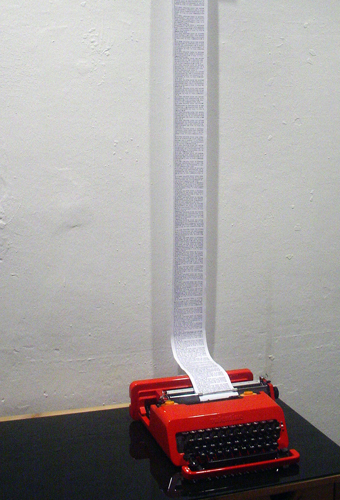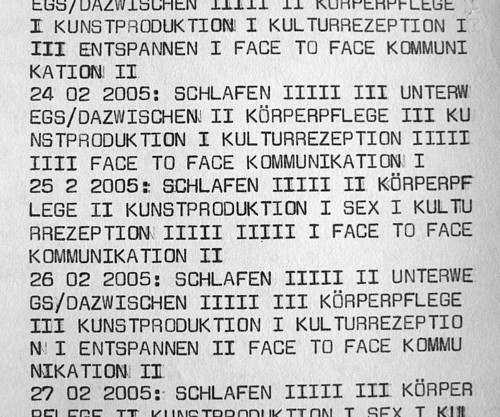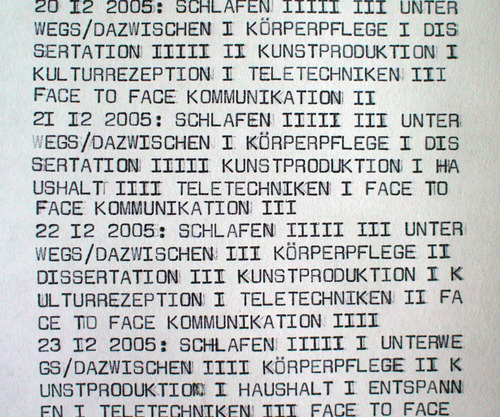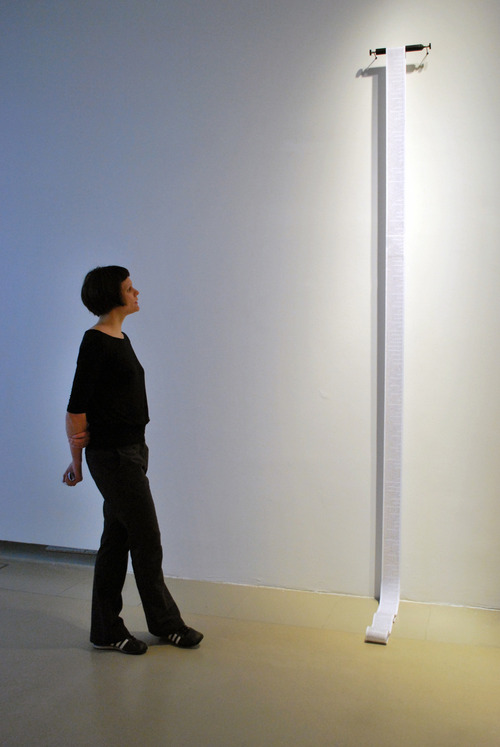
Installation, Schreibmaschinenlettern auf Endlospapier, Breite 10cm
2005
Das Tagebuch als mechanisch-kybernetisches Protokoll? Eine schmale Rolle Endlospapier bildet das Trägermedium der „temporal translation“ von Arnold Reinthaler. Der Künstler hält darauf – gleich einem täglichen Ritual – Tätigkeiten seines Tages in zwölf Kategorien mittels einer mechanischen Schreibmaschine fest. Reinthalers Zeiteinheit wird hierbei von einem einfachen typografischen Zeichen symbolisiert: ein Strich steht für eine Stunde Lebens- bzw. Handlungszeit. Die Kategorien sind Essen, Schlafen, Kommunikation usw. Der Strich figuriert die temporale Kleinsteinheit in Reinthalers Chronometrie. Der Künstler konfrontiert in dieser Zeitsemiose komplementäre Gedächtnismodelle. Er stellt der Individualität des Erinnerns die metrisch-lineare Aufzeichnung eines analogmechanischen Speichermediums gegenüber. Biographische werden in semantisch-lexikalische Einheiten konvertiert. In dieser Reduktion schlägt sich die Arbeit mehr auf die Seite „der Infrastruktur von Macht (Verwaltung), denn auf Seiten anthropologischer Bedürfnisse nach Verzeitlichung der Erfahrung.“ Anstelle der Repräsentation von „Eigenzeit“ der aufgezeichneten Handlungen avanciert vielmehr die rituelle nachträgliche Aufzeichnung (Schreibzeit) zur eigentlichen Mnemotechnik Reinthalers. Gerade durch die Indifferenz der übersetzenden Zeichen kommt es zur Bildung einer Reihe, einer Chrono-Logie. Es ist diese Formation einer Zeitzeichenkette, welche die Fortsetzbarkeit erst vorstellbar macht. Nur so kann zukünftige, noch unstrukturierte Zeit imaginiert bzw. projiziert werden. Gerade in der Nicht-Sichtbarkeit und den Auslassungen biographischer Spuren formiert die reduktive Symbolisierung der Ereignisse bzw. Handlungen ein Differenzial des Zeitlichen: Zeit erscheint als eine „Dimension der Bestimmung von Sinn“, sprich als Prozess permanenter und stets gegenwärtig ablaufender Konstitution und Antizipation von Zukünftigem aus dem Erinnerten. „Wiederholung und Erinnerung stellen die gleiche Bewegung dar, nur in entgegengesetzter Richtung; denn, woran man sich als Gewesenes erinnert, das wird in rückwertiger Richtung wiederholt; wohingegen die eigentliche Wiederholung Erinnerung in Richtung nach vorn ist.“ Das repetitive und ritualisierte Aufzeichnen wird somit als eine Technik der (projektiven) Selbstvergewisserung lesbar. In diesem Verständnis ist auch nicht von Bedeutung was, sondern dass eine Handlung vollzogen wurde. „Temporal translation“ erscheint somit weniger als Logistik und Analytik zeitlicher Semantik, sondern als ein Repetitionsritual, das Zeit mittels der Relektüre von Vergangenem zu modellieren und figurieren vermag. So kann, im Sinne Kierkegaards, Vergangenheit durch Wiederholung in die Zukunft hineingetragen, quasi nach vorn erinnert werden. Gerade die ästhetische Indifferenz und Gleichförmigkeit der chronometrischen Einheiten in Reinthalers Zeitsemantik evoziert schließlich die (vermeintlich) sichernde Illusion von Fortsetzbarkeit des eigenen Projekts.
David Komary, time offset, phase signatures, in: dreizehnzwei (Hg.), dreizehnzwei – selected exhibitions 2003-2008, SCHLEBRÜGGE.EDITOR,Wien 2008
installation, typewritten letters on continuous paper, width 10cm
2005
The diary – a mechanical-cybernetic protocol? The basic medium of Arnold Reinthaler’s “temporal translation”is a narrow roll of continuous paper. On this, the artist records hid daily activities in twelve categories using a mechanical typewriter in a kind of daily ritual. Reinthaler’s time units are symbolised here using simple typographic signs: one line stands for one hour of time, either in his life or of a particular activity.The categories are eating, sleeping, communication etc.The line figures as the smallest temporal unit in Reinthaler’s chronometry. In this time semiosis, the artist thematises complementary models of memory. He juxtaposes the individuality of memory with the metric, linear recording of an analogue mechanical means of storing memory. Biographical units are converted into semantic, lexical units. In this respect, the reductive nature of the work makes it more representative of “the infrastructure of power (administration) than of any anthropological need to understand experience in temporal terms”. Instead of representing the “inherent time”of the activities recorded, the ritual, retrospective recording itself (writing time) becomes Reinthaler’s actual mnemonic device.The indifference of the signs used to translate time here leads to the creation of a series, a chrono-logy. It is the very formation of this chain of time signs that makes the idea of continuity thinkable here. Only in this way can future time, as yet unstructured, be imagined or projected. It is precisely in this invisibility and omission of biographical traces that the reductive symbolisation of events or activities form a differential of time: time appears as a “dimension of the determination of meaning,”that is to say, as a permanent process whereby memory is continually being unfolded to constitute and anticipate the future. “Repetition and memory represent the same movement, just in the opposite direction; whatever we remember as something that has already been, is repeated backwards; whereas actual repetition is memory in a forward direction.”(Kierkegaard) In this sense, repetitive and ritualised recording can be read as a technique of (projected) self-ascertainment. It is not so much important what activity has been done, but rather that it has been performed at all. Instead of a logical and analytical approach to chronological semantics, then,“temporal translation”is ritualised repetition, able to model and configure time by re-reading what is past. In this way, as Kierkegaard wrote, the past can be carried into the future through repetition, almost as if were being remembered in anticipation rather than in retrospect.The chronometrical units of Reinthaler’s semantics of time may be aesthetically indifferent and uniform, but it is this very uniformity that ultimately evokes a reassuring assumption or illusion of continuity.
David Komary, time offset, phase signatures, in: dreizehnzwei (Hg.), dreizehnzwei – selected exhibitions 2003-2008, SCHLEBRÜGGE.EDITOR,Vienna 2008
—

 –
–
–

 ‚Übersetzung ist eine Form. Translation is a mode‘, Kunstraum NÖ, Wien 2010
‚Übersetzung ist eine Form. Translation is a mode‘, Kunstraum NÖ, Wien 2010